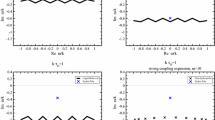Summary
The branch-cut contribution to the longitudinal electric field in a relativistic Maxwellian plasma is evaluated in the long-time limit by a procedure which does not depend upon the Laplace transformation method. The analytic-continuation difficulty inherent in previous work in this field is thereby eliminated.
Riassunto
Nel limite del tempo lungo si valuta il contributo del taglio di suddivisione al campo elettrico longitudinale in un plasma maxwelliano relativistico con un procedimento che non dipende dal metodo della trasformazione di Laplace. Si elimina così la difficoltà della continuazione analitica, propria dei precedenti lavori su questo argomento.
Реэюме
Оценивается вклад от раэреэа в продольное злектрическое поле в релятивистской Максвелловской плаэме, в пределе больщих времен, с помошью методики, которая не эависит от метода преобраэования Лапласа. Следовательно, эдесь исключается трудность аналитической непрерывности, которая была свойственна предыдушей работе на зту тему.
Similar content being viewed by others
References
For a critical review of this work seeD. C. Montgomery andD. A. Tidman:Plasma Kinetic Theory (New York, 1964).
F. Santini andG. Szamosi:Nuovo Cimento,37, 685 (1965).
R. Aaron andD. Currie:Phys. Fluids,9, 1423 (1966). This work is limited to the case of a one-dimensional plasma.
The integral equation (1) is written in the form first proved for the case of an equilibrium nonrelativistic plasma byM. N. Rosenbluth: inPlasma in a Magnetic Field (Stanford, Cal., 1958), p. 23. More general derivations for the nonrelativistic plasma were given byG. Backus:Journ. Math. Phys.,1, 178 (1960);J. N. Hayes:Phys. Fluids,4, 1387 (1961);A. W. Sáenz:Journ. Math. Phys.,6, 859 (1965). The only difference between the nonrelativistic and relativistic cases is that the inhomogeneous term,g(t), and the kernel,K(t), have different forms.
See, for example,F. G. Tricomi:Integral Equations, Chap. 1 (New York, 1957). It is shown in this reference that ifg(t) andK(t) belong toL 2(0, ∞) then there exists one and only one solution,E(t), of eq. (1) inL 2(0, ∞). A uniqueness theorem with different conditions has been proved by Sáenz in the paper cited in the previous footnote for the nonrelativistic form of eq. (1). His proof is also valid in the present case with only trivial modifications.
These poles were first found byB. Buti:Phys. Fluids,5, 1 (1962) in the extreme relativistic limit. For a more general treatment see ref. (2).
N. G. De Bruijn:Asymptotic Methods in Analysis, Chap. 5 (Amsterdam, 1958).
Author information
Authors and Affiliations
Rights and permissions
About this article
Cite this article
Zachary, W.W. Branch-cut contribution to the longitudinal electric field in relativistic plasmas. Nuovo Cimento B (1965-1970) 51, 71–81 (1967). https://doi.org/10.1007/BF02712322
Received:
Published:
Issue Date:
DOI: https://doi.org/10.1007/BF02712322




